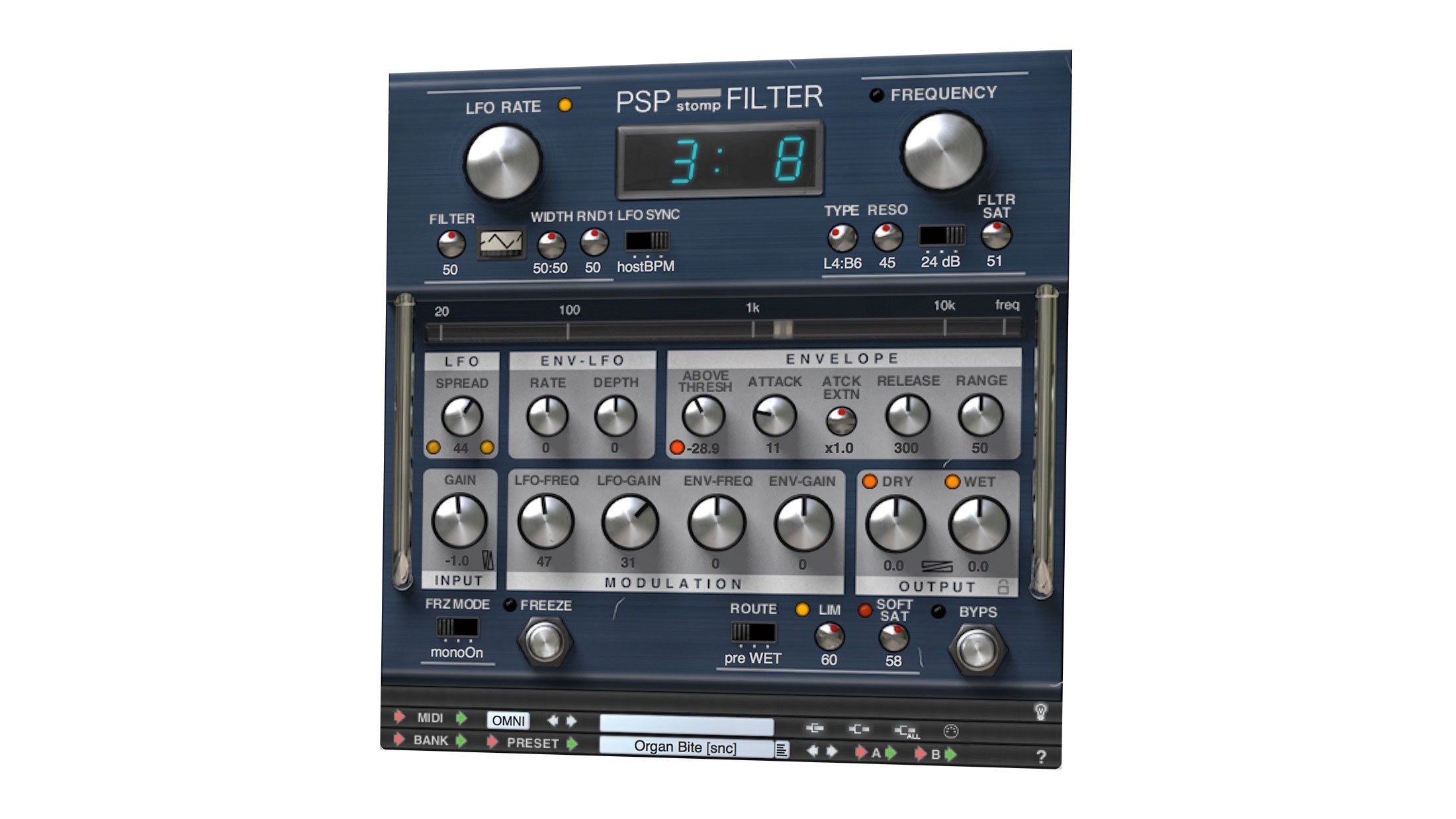MusicRadar Verdict
PSP's action-packed and endlessly creative frequency-shaping plugin delivers fabulous hardware-style filtering, both in the studio and on stage. A must-have!
Pros
- +
Lovely GUI . Morphing filter . Awesome sound.
Cons
- -
A 36dB/octave option might be fun.
MusicRadar's got your back
The second in its 'stomp' line of stompbox-inspired plugins, stompFilter (VST/AU/AAX/ RTAS) sports the same brand of handsome photorealistic fascia as its stablemate, stompDelay, and is built with modulation similarly at the top of the agenda.
While said modulation in stompDelay's case was of delay time, here it's of filter cutoff, as well as volume. The modulation signals are generated by an LFO and an envelope follower, or a combination of the two, between them enabling highly controlled rhythmic frequency shaping.
The stompbox angle, we suppose, comes from the single-screen interface, easy operation, and guitar pedal-style Bypass and Freeze buttons. With all of stompFilter's knobs and switches so readily accessible and not a selection menu in sight, serious plugins don't get much more user-friendly than this.
Get moving
The LFO section occupies the top left of the GUI, opposite the filter controls. The Rate is set using the so-named knob and ranges from 0.01-15ms unsynced, or from eight bars to 64th-note, either synced to host tempo or with the tempo freely set anywhere between 15 and 600bpm.
Seven waveshapes are onboard, comprising all the analogue staples, as well as Random and Spike, the last generating very fast periodic up/ down movements from a flat baseline. The pulse width of the wave is adjustable from 75:25 to 25:75 (with 50:50 as default), and an underlying low-pass filter can be applied to shape its output. Fast or slow chaotic fluctuations are dialled in with the Random knob, while the Spread knob governs phase offset between the left and right channels.
About that filter
The actual filter at the heart of stompFilter sounds fantastic - although that shouldn't be a surprise, given the number of top notch EQ plugins in PSP's catalogue.
A resonant model, it offers 12dB and 24dB/octave roll-off slopes, and the Type knob morphs the response seamlessly from low-pass through band-pass to high-pass. The cutoff frequency is swept (from 20Hz to 20kHz) using the Frequency knob or the slider above the Envelope controls, the scale of which can be switched between frequency in Hertz and note pitch, from A0 to A9.
Weirdly, you can't jump the slider to a specific frequency by clicking without holding the Alt key first. The precise current frequency is shown in the faux LED display, which also shows the LFO speed or tempo when the LFO Rate knob is moused over.
Last but not least, the Saturation control introduces analogue-style distortion, adding further warmth and bite.
Pushing the envelope
The Envelope Follower is a three-stage affair (Attack, Release and Hold-like Attack Extension), with three Threshold settings determining whether it's triggered by signals Above, Below or Around an adjustable input level.
The LFO and Envelope Follower are each routed to the filter cutoff and/or gain in the Modulation section by clicking the assignment names to activate them, and twisting the accompanying knobs to set the modulation depths. As well as controlling the filter cutoff in its own right, the Envelope Follower can also be set to modulate the LFO, for dynamic automation of LFO speed and/or mod depth.
Finally, the Output section offers independent Wet and Dry levelling, while at the bottom of the interface, the performance-orientated Freeze button simply 'holds' all modulation when toggled; the adjustable Limiter and Soft Saturation circuits have
three signal flow placements (pre and post wet, and post mix); and PSP's usual comprehensive preset management and MIDI learn systems are in place.
Although it might not appear in any way remarkable alongside comparable plugins of the same ilk, what give stompFilter its edge are the superb quality of the filter itself - sharp, smooth, responsive and fluid - the deep LFO shaping options, and the Env/LFO cross-modulation setup. Straightforward and intuitive in use, and smooth and musical in sound, it all adds up to a super-flexible effect for whipcrack filtering, funky auto-wah, auto-panning, pseudo- compression and more.
Computer Music magazine is the world’s best selling publication dedicated solely to making great music with your Mac or PC computer. Each issue it brings its lucky readers the best in cutting-edge tutorials, need-to-know, expert software reviews and even all the tools you actually need to make great music today, courtesy of our legendary CM Plugin Suite.
“A fabulous trip through all eight songs by 24 wonderful artists and remixers... way beyond anything I could have hoped for”: Robert Smith announces new Cure remix album
“He knows what I'm thinking and feeling before I even know it": Billie Eilish suggests that she and brother Finneas can read each other's minds
“A purpose-built solution for bassists seeking unparalleled sound-shaping capabilities”: Darkglass Electronics unveils the Anagram Bass Workstation – a state-of-the-art multi-effects for bass guitar with neural amp model support and a 7” touchscreen











